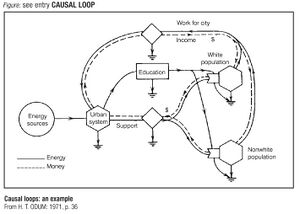CAUSAL LOOP
| Collection | International Encyclopedia of Systems and Cybernetics |
|---|---|
| Year | 2004 |
| Vol. (num.) | 2(1) |
| ID | ◀ 371 ▶ |
| Object type | General information, Epistemology, ontology or semantics, Methodology or model |

A cause and effect relation closed on itself.
A causal loop is the result of a feedback of the effect upon the cause. Interconnected causal loops may become very complex. This model has been extensively explored by M. MARUYAMA (1994, p.75-87).
The feedback can also take the form of a circular and cyclical chain of feedbacks. It can reduce, maintain or amplify the process.
MARUYAMA explains: “The dynamics of causal loops has two aspects: quantitative and qualitative. The former is a matter of change amplification and change counteraction; the latter deals with heterogeneity and interrelations among heterogeneous elements, as well as the creation of new patterns and inventive processes” (p.75).
At the beginnings of cybernetics, much emphasis was on reducing or stabilizing causal loops. This is still the case in some disciplines. In MARUYAMA's words: “Causal loops have become invisible in the black box, and we have fallen back on loopless input/output relations”. LEONTIEFF's input/output matrixes in economic theory are a typical case.
MARUYAMA moreover observes that: “Economists tend to ignore change-amplifying causal loops and believe in equilibrium or the cycle almost superstitiously” (p.75). See “Economics in systemic terms”.
MARUYAMA offers a causal loops notation with the needed explanations (p.76-80). He insists on the importance of initial states, reversal effects and of time delays.
See also
figure below